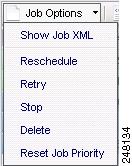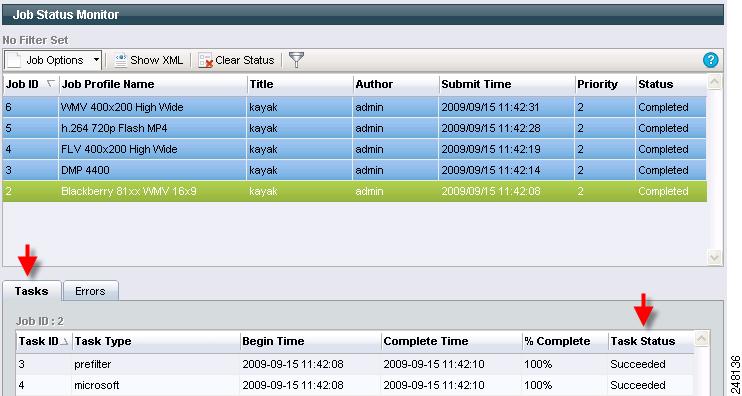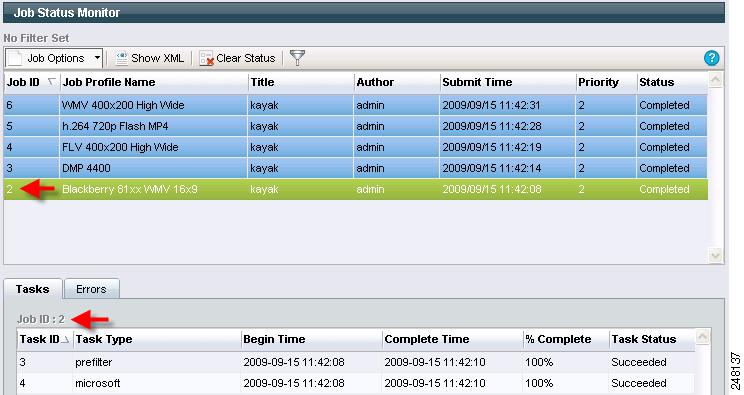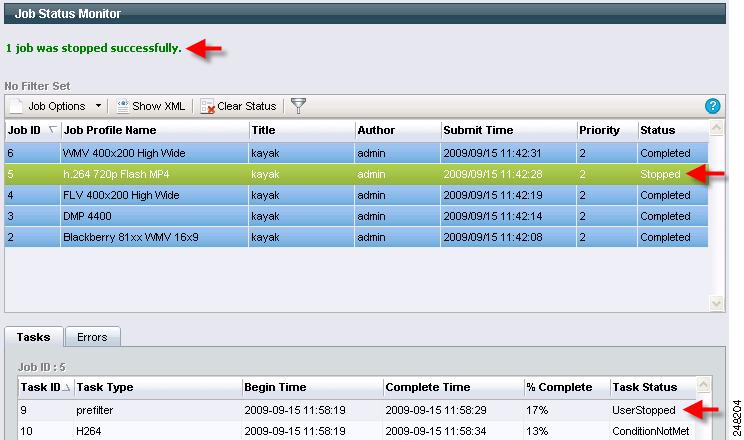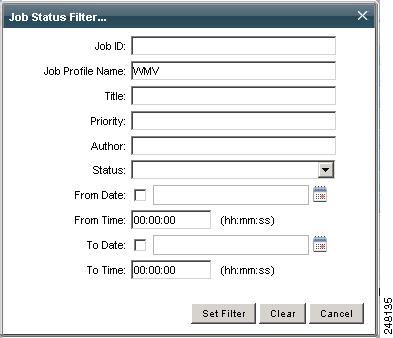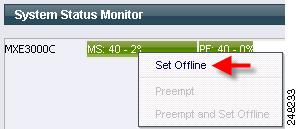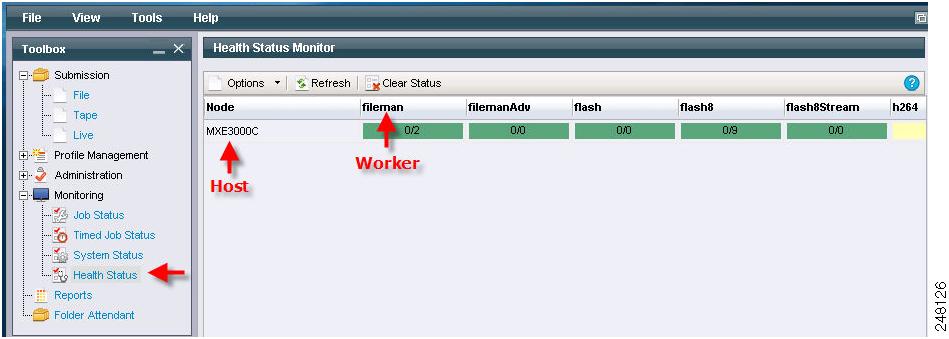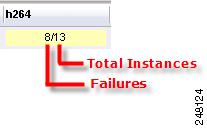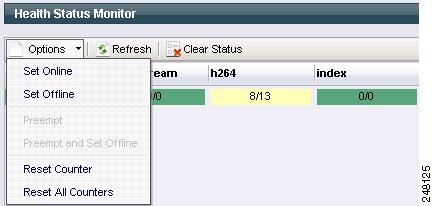

Table Of Contents
Viewing Directory/Watch Status
Working with Jobs in Timed Job Monitor
Pausing and Removing Timed Jobs
Working with the System Status Monitor
Working with the Health Status Monitor
Job Monitoring and Management
This section includes the following topics:
Job Status
This section includes the following topics:
•
Viewing Directory/Watch Status
Job Status Overview
View job status and perform tasks related to job status from with the Job Status Monitor. It displays all jobs that have not been reaped (deleted by the system).
To access the Job Status Monitor:
•
From the toolbox, select Monitoring > Job Status
OR
•
From the main menu, select View > Monitoring > Job Status
See Figure 15-1.
Figure 15-1 Job Status Monitor Upper Pane
The Job Status Monitor upper pane displays the jobs that are currently pending, running, complete, or failed. Jobs are color coded based on their status. See also: Monitoring Jobs.
The jobs displayed may disappear as you are viewing them because the system automatically removes (reaps) jobs based on the Auto Reap Interval. The Auto Reap Interval specifies how long job information displays on the Job Status Monitor before it is cleared from the Monitor. When the system reaps jobs, it removes data that has been processed and completed. The Auto Reap Interval begins from the time a job completes (or when it fails).
The upper pane of the Job Status Monitor provides job information as described in Table 15-1.
Note
Click any of the headings (Job ID, Job Profile Name, etc.) at the top of the Job Status Monitor to sort the open jobs by the selected field. By default, jobs are sorted from most recently submitted to earliest submitted.
If all jobs do not display, use the scroll bars to view the remaining jobs.
Job Options
On the Job Status Monitor page, click the arrow to the right of the Job Options button to display the following. Most of the options are self-explanatory, except that Reschedule resubmits the entire job from scratch, and Retry resubmits failed or dependent tasks only. Retry is particularly useful, for example, when the encoding has completed but distribution fails. See Figure 15-2.
Figure 15-2 Job Options
See also: Monitoring Tasks.
Monitoring Jobs
Monitor the status of all jobs submitted in the Cisco MXE 3500 system from the Job Status Monitor page.
To access the page, from the Toolbox, expand Monitoring, and click Job Status.
Each job contains multiple tasks. To view the tasks associated with a job and their status, double-click the job row in the upper pane (shown here in blue). The tasks display in the lower pane on the Tasks tab. See Figure 15-3.
Figure 15-3 Job Status Monitor Page
This page shows several jobs that are in progress or that have recently been completed. Jobs are color-coded based on the status described in Table 15-2.
Table 15-2 Job Status Color Coding
Pending
Yellow
The job has been submitted, but work has not yet begun.
Running
Green
The job has been submitted and work has begun. The job stays in Running status until all tasks in the Job Profile have been executed or until the job is determined to have failed.
Completed
Blue
All the tasks in the job profile have completed successfully.
Failed
Red
One or more tasks in the Job Profile could not be completed successfully. For example, if communication with an FTP service cannot be established, the job will fail because the distribution task cannot be completed successfully. Similarly, if you stop a job, it will fail with the following error message: user stop request.
If a job fails, select the Errors tab for a summary of errors that have occurred. (To obtain additional details on why jobs failed, contact your Cisco MXE 3500 administrator.) Take the necessary actions to correct any jobs that have failed, and resubmit or reschedule the job.
You may also view the XML code for a selected job for more detail on how it is being processed. See also: Showing Job XML.
Stopped
Orange
User stopped the job.
Tip
If all of the jobs are not displayed, use the scroll bars to view the remaining jobs.
Monitoring Tasks
The lower pane of the Job Status Monitor displays job tasks or job errors, depending on which tab you select. Double-click a job in the upper pane to display its tasks or errors in the lower pane. See Figure 15-4.
Figure 15-4 Job Status Monitor Tasks
Each task within the job, and its status, are listed. Task fields are described in Table 15-3.
Table 15-3 Task Field
Task ID
Displays a unique numerical ID the Cisco MXE 3500 assigns to each task within the job.
Task Type
The task type represents the specific type of task that is executed by a given worker (examples: Preprocessor, Flash encoder, File Manager, etc.) on a specific node. The tasks are defined by the Job Profile selected for the job. See also: Job Profiles.
Begin Time
Displays the time when the task was started.
Complete Time
Displays the time when the task was completed.
% Complete
Displays the percentage of the task that is currently complete.
Note
For Speech to Text tasks, the numbers displayed here represent time elapsed.
Task Status
Displays the current status of the task.
Possible values are:
•
Dependent Task: Execution is dependent on one or more other task status events (start or complete events).
•
Pending: The task is waiting to be scheduled.
•
Provisioned Task: The task has acquired license(s) and a node worker. It is now waiting for notification from the LCS that the task has started.
•
Running: The task is being executed by a worker on an LCS node.
•
StopRequest: The task is being halted by the scheduler or operator. A terminate request was sent to the LCS. Waiting for a confirmation from LCS that the task is complete.
•
Succeeded: The task has completed successfully.
•
Failed: The task failed on the LCS or was invalid.
•
UserStopped: The task was stopped at the request of the operator. It will not be rescheduled.
•
ConditionNotMet: The task cannot be run because a start condition will never be met.
•
Preempted: The system or operator preempted the task execution. Task should be rescheduled.
Viewing Errors
Click the Errors tab to view task error information as described in Table 15-4.
Error Types and Possible Solutions
There are many types of errors that might display, including the following:
•
Network errors or permission issues: Try rescheduling the job to see if the network errors clear, and/or recheck permissions. (To obtain additional details on network and permission issues, contact your Cisco MXE 3500 administrator.)
•
Errors related to Folder Attendant not running: View the Folder Attendant Log to determine a possible cause.
•
Errors related to the system not running: Contact your Cisco MXE 3500 administrator.
•
Errors related to jobs failing: Check to see that job profiles are set correctly and that valid media is chosen for that profile, and resubmit the job.
See also: Troubleshooting Cisco MXE 3500.
Viewing Output Clip
To view the output clip, from the Tasks menu, right-click a task, and click View Output Clip. See Figure 15-5.
Figure 15-5 Viewing Output Clip from Job Monitor Tasks Menu
Note
You may only view clips from the same domain on which the clip resides.
Viewing Directory/Watch Status
The Folder Attendant Administration page shows the directories and watches that have been defined. See Figure 15-6.
Figure 15-6 Configured Directories and Watches
If a directory has been defined, but a watch has not been defined for the directory, the Profile, State and # Files fields are blank for the directory. If a watch has been defined for the directory, those fields are populated.
Table 15-5 shows the field that are displayed.
You can also filter the directories that are displayed in this page to view only those directories of interest.
Showing Job XML
Job XML provides detailed instructions used by the Cisco MXE 3500 system to execute a job. If you encounter any job submission problems, the Cisco MXE 3500 Technical Support Team may request XML code (and log files) to assist them in troubleshooting the issues.
Procedure
Step 1
Access the Job Status Monitor page.
Step 2
Select the job, and click Show Job XML. See Figure 15-7.
Figure 15-7 Show Job XML
Step 3
The XML code displays on a new page.
Step 4
If all of the XML code is not displayed in the page, use the scroll arrows on the right side of the page to view all the code.
Step 5
When you are done viewing the XML, select the X in the top right corner to return to the Job Status Monitor page.
Rescheduling Jobs
Rescheduling a job will re-queue it. If the job is currently running, all of its tasks are stopped, and then the job is rescheduled. If you reschedule a job that has failed, it will attempt to run again, as soon as it is able. When you reschedule jobs, you do not have the option of specifying an exact time when they will run.
If there was a network problem that prevented the job from running, you can reschedule the job after the network problem clears to attempt to process it successfully. However, if the job failed because of a problem with the profile, examine the Error tab on the Job Status Monitor page and the LCS log file, make the necessary changes, and then resubmit the job.
Procedure
Step 1
Access the Job Status Monitor page.
Step 2
Select the job(s), and from the Job Options drop-down, click Reschedule. See Figure 15-8.
Figure 15-8 Select Job to be Rescheduled
A message displays at the top of the page indicating that the job has been successfully rescheduled. See Figure 15-9.
Figure 15-9 Successful Reschedule Message
Step 3
Double-click the job to monitor its progress.
Stopping Jobs
You may choose to stop a job for a number of reasons: You may have chosen the wrong profile, or the job may be taking too long to process and you want to stop it to free up resources for other more critical jobs.
If you stop a job, the status of the job will change to Stopped.
Procedure
Step 1
To stop a job, access the Job Status Monitor page.
Step 2
Select the job(s), and from the Job Options drop-down (or right-click menu), click Stop. See Figure 15-10. A stop confirmation message displays.
Figure 15-10 Select the Job(s) to Stop
Step 3
Select OK to stop the selected job(s). A message displays at the top of the Job Status Monitor page indicating the ID number of the job that was stopped. The Status field updates with the current status (failed).
Step 4
Select the Errors tab to view the Failure Message. See Figure 15-11.
Figure 15-11 Selected Jobs Have Been Stopped
Deleting Jobs
When you delete a job, it no longer appears in the status monitor and cannot be stopped, rescheduled, or viewed. Any job (in any state) can be deleted.
Procedure
Step 1
Access the Job Status Monitor page.
Step 2
Select the job, and from the Job Options drop-down, select Delete. See Figure 15-12. A delete confirmation message displays.
Figure 15-12 Select the Job to be Deleted
Step 3
Select OK to delete the selected job(s). A message displays indicating which job has been deleted. The deleted job is removed from the job list. See Figure 15-13.
Figure 15-13 Selected Job Has Been Deleted
Resetting Job Priority
Increase or decrease the priority of a job to change the order in which jobs are processed if multiple jobs are pending. Job priority can be set from 1-100 with 1 as highest priority and 100 as lowest priority.
Jobs with higher priority (a lower priority number) will be processed before jobs with lower priority.
Note
Job Priority is a goal for the Cisco MXE 3500 system. Due to resource availability and the job profile selected, a lower priority job may still be scheduled before a higher priority job. There are also special cases where certain higher priority jobs can preempt a lower priority job (as in the case with live jobs) if there are no resources available.
You can only set (or reset) job priority if you have a Resource Manager license.
Procedure
Step 1
Access the Job Status Monitor page.
Step 2
Select the job(s), and from the Job Options drop-down menu, select Reset Job Priority. See Figure 15-14.
Figure 15-14 Select the Jobs for which Priority Will be Reset
Step 3
A Reset Job Priority pop-up displays. Enter the new number (1-100), and click Set Priority. The following message displays, and the Priority field is updated. See Figure 15-15.
Figure 15-15 Priority for the Selected Job Reset
Filtering Jobs
The Filter button on the Job Status Monitor page allows you to display a subset of all the jobs. Filter jobs using any of the following parameters (or any combination of these parameters):
•
Job ID
•
Job Profile Name
•
Title
•
Author
•
Submit Time
•
Priority
•
Status
Note
Even if jobs are filtered, they are still being processed as usual. This function only limits the number of jobs displayed on the page.
Procedure
Step 1
Access the Job Status Monitor page. See Figure 15-16.
Figure 15-16 Jobs Before Filters Have Been Applied
Step 2
Select the Filter button from the menu bar. The Job Status Filter pop-up displays. See Figure 15-17.
Figure 15-17 Job Status Filter Pop-Up
Step 3
Complete one or more fields to specify how to filter the job status display. For example, if you enter All Streaming in the Job Profile field, that means that only the jobs that have the All Streaming profile are displayed. The filtering fields are described in the following table:
Step 4
When you have complete the desired fields, click Set Filter. The Job Status Monitor page is updated and displays only jobs matching the filter fields.
Timed Job Status
This section includes the following topics:
•
Working with Jobs in Timed Job Monitor
•
Pausing and Removing Timed Jobs
Timed Job Status Overview
The Timed Job Status page is used to display summary information on timed jobs that are essentially on hold until their designated Start Time. Timed jobs are created by checking the Enable Timed Submission box on the Job Submission page. See Figure 15-18.
Figure 15-18 Timed Job Status Monitor
Working with Jobs in Timed Job Monitor
Figure 15-19 shows available Timed Job Monitor options. Table 15-8 describes the options.
Figure 15-19 Timed Job Monitor Job Options
Cancelling Future Timed Jobs
Procedure
Step 1
In the Timed Job Monitor, right-click a job.
Step 2
Click Delete Job.
Step 3
When the delete confirmation pop-up displays, click OK.
Pausing and Removing Timed Jobs
Procedure
Step 1
To pause a timed job:
a.
In the Timed Job Monitor, right-click a job.
b.
Click Pause Job. The job moves to the top of the list, and displays a status of Inactive.
Step 2
To resume a timed job:
a.
In the Timed Job Monitor, right-click a job.
b.
Click Resume Job. The job moves back to its original position, and displays a status of Active.
System Status
This section includes the following topics:
•
Working with the System Status Monitor
System Status Overview
View information about system components currently involved in processing jobs with the System Status Monitor. This page displays one line of information for each host in the system. Each line contains bars that represent an encoder or other worker.
To access the System Status Monitor:
•
From the Toolbox, select Monitoring > System Status
or
•
From the main menu, select View > Monitoring > System Status
See Figure 15-20.
Figure 15-20 System Status Monitor
The name of the host is displayed in the first column, followed by bars which represent the tasks currently running on the host.
The colored bars for each task indicate the type of worker that is running, the Job ID, and the percentage of the task that is complete.
For example, the two colored bars below indicate:
•
A Microsoft encoder running Job ID #28 is 2% complete.
•
A prefilter running Job ID #28 is 0% complete.
If the status area extends beyond the visible area, use the horizontal scroll bar at the bottom of the page to view all tasks for the host.
The status area only shows tasks that are currently running. Once tasks are complete, they no longer display. Similarly, encoders and other workers for which you do not hold that license will not run, and therefore, will not appear on the System Status Monitor.
Note
The Max Cap value that appears on the right side of the pane displays the maximum number of tasks that can run on one node at one time. Capacity is set on the Host Administration page. See also: Host Administration.
Working with the System Status Monitor
The System Status Monitor allows you to interact with running tasks. See Figure 15-21 shows the options. Table 15-9 describes the options.
Figure 15-21 System Status Monitor Right-click Options
Health Status
This section includes the following topics:
•
Working with the Health Status Monitor
Health Status Overview
Each host configured to function as part of the Cisco MXE 3500 is assigned tasks depending on the workers configured for that Host. The Health Status Monitor allows you to track the performance of these workers over time. See Figure 15-22.
Figure 15-22 Health Status Monitor
Each row in the Health Status Monitor reflects workers run on a particular host. The Host is listed in the column at the far left, and each block in the row shows statistics on an individual worker. Information about each worker is displayed in the worker blocks in two ways:
Color
The color of the worker block indicates the general performance history, or health, of the worker on that particular host. Table 15-10 describes the job options.
Health Counter
The values shown in the health counter reveal more detailed information about the performance of the worker. Where color gives a general reading of the health of the worker, the health counter reflects the exact number of times that the worker has failed to complete compared to the total number of times the worker has been run. The first number indicates the number of failures. The second number indicates the total number of times the worker has run since the last time the ECS was restarted. See Figure 15-23.
Figure 15-23 Health Counter
Working with the Health Status Monitor
The Options menu in the Health Status Monitor allows you to interact with workers. This menu can also be accessed by right-clicking any worker block in the list. See Figure 15-24. Table 15-11 describes the job options.
Figure 15-24 Health Status Monitor Options

 Feedback
Feedback

